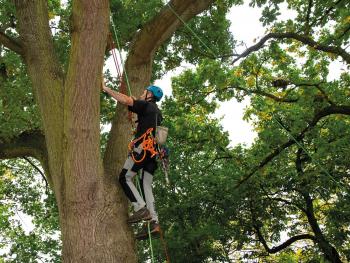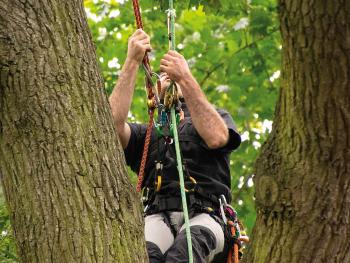Working on a Two-Rope System
8th Jan 2020As we're sure most of you are now aware, the HSE is now requiring full compliance with Work at Height regulations within our industry, and more to the point this is in relation to the use of a two-rope system when climbing during tree operations.
This has actually been the recommended guidance since 2005, but hasn't been adequately taught or properly enforced, so many arborists & tree surgeons haven't been climbing to the full regulations. This has, in part, been a cause in falls from height, which every single one of us want to eliminate from our industry. Stuart Barry, HM Inspector of Health & Safety had this to say:
"Climbing and working with a single rope has remained the custom and practice in the industry for too long and been a factor in many falls from height. Recognising this, some clients in the utility sector have shown the way forward by ensuring their contractors use two ropes. HSE strongly support efforts by the AA to promote this system of work through its publications so that more climbers and businesses understand it is necessary to reduce risk and comply with the law"

The Arb Association have now updated their guidance to so that we are all aware of what compliance is needed by law, and remove any doubt when discussing this with suppliers, colleagues, sub contractors and clients. All the guidance on this can be found directly on the Arb Association website.
The outcome is that we now have a "Hierachy of Approach" for the use of two ropes, as detailed below:

A basic set of practical guidance has also been laid out to make it clear about the use of the systems:
Access
- Have 3 viable systems prior to leaving the ground (2 climbing lines, 1 lanyard). Install systems 1 & 2 (2 climbing lines) from ground. Test each system. Ascend to first anchor.
- Maintain 2 climbing systems at all times
- Repeat to final anchor point
Working in the tree
- Select 2 separate load-bearing anchors where possible and install 2 separate climbing systems. Test systems independently.
- Work using 2 independent climbing systems.
Descent
- Both primary & secondary working systems should be long enough to descend to the ground.
Rescue
- A single line system may be acceptable in a rescue situation.

Due to this announcement and system becoming essential for professional use by all arborists, we have seen a significant uplift in enquries and sales on ropes, climbing kits, climbing hardware, and the rules surrounding the update. We are trying our best to keep our high stock levels as always in everything required, but as we have found, some manufacturers are also being a bit caught out particularly by the sudden need for more ropes, with Teufelberger, Marlow, Yale and Stein all included. All our climbing kit can be found HERE, but below we have set out our 5 top tips for kit to get compliant.
1. Make sure your secondary climbing line can reach the ground
Initially when all this information was first given out, we saw an increase in demand for short lengths of rope. While cheaper, this is not actually compliant if you normally work in large trees, and both ropes need to be long enough to get you to the ground. It is also recomendded that both ropes have a spliced end, rather than just buying an odd length off of a reel and tying a knot. You'll also need a kitbag big enough for both systems, we keep plenty of good sized kit bags in stock HERE.
2. Use different coloured hardware for your secondary system
These new guidelines will cause jobs to take longer, but you need to make sure you're always concentrated on which particular system you are using at the time. Using different coloured hardware will be massively helpful, so things like the DMM Triple Pack of Karabiners are really useful to differntiate between your systems. Make sure you get a different coloured rope too, again we keep wide range of colours of ropes in stock which can be found HERE.
3. Get you diameters right
Perhaps you've got an old mechanical device like a ZigZag that you haven't used for a while thats still in good working order and might help save a few pounds when pricing up another system. Well don't go buying a 13mm rope which may be cheaper. Although it might get through the ZigZag at a push, it won't run smoothly and could shred the outer of the rope very quickly, leaving you with having bo buy yet another line.
4. Make sure everything is clean and LOLER checked
If you do end up bringing in previously used kit, or you're not sure on how long something has been in use, its best to get it all cleaned and checked ASAP. Regulators will be extremely hot on checking up on these systems this year as it comes into full effect, so you don't want silly mistakes costing you if its checked. Ropes can be a hard one to clean if you have a backup that you can bring straight into use, so our Teufelberger Scrubba Rope Wash is a really cost-effective way of properly cleaning a rope and getting it back up to a safe standard
5. Don't take anything from a rescue kit to get you by 'for a while'
While it might be tempting to grab some kit from an aerial rescue bag to get started, it can be easy to forget you've taken it out and if that rescue kit is ever needed, you or a colleague are in trouble. If in doubt, make sure you buy new kit and get yourself compliant ASAP.
More detail, FAQs, and other helpful info is available via the Arb Association at the following link: AA Two Rope Work